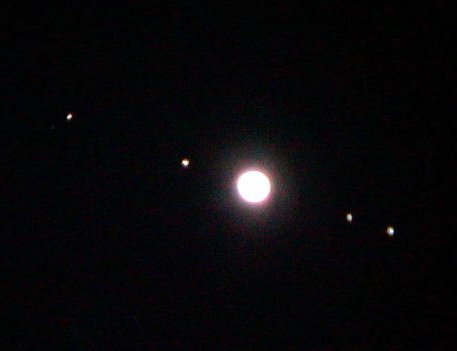| From any
telescope on
Earth, a view of
Jupiter and its four main moons are possible.
Galileo Galilei, an Italian Astronomer, discovered
the four moons of Jupiter in 1609 (along with the
phases of
Venus) using a new invention called a
telescope.
More information can be found on the Galilean Moon Fact Sheet.
The discovery of the phases of
Venus and the orbits of the four moons of Jupiter helped
to add evidence of the
Sun-centered
Universe (heliocentric). For the longest time, scientists
believed the
Earth was at the heart of the
Universe.
We now know that we reside on the edge of an
"average" spiral galaxy among a population of
several
galaxies that are members of the
Universe -
there is no center. As seen from a small
telescope on
Earth, you may see Jupiter and its four main
moons like this:

The four main moons of Jupiter are:

The image above shows, from left to right:
Callisto,
Ganymede,
Europa, and
Io. These sizes
are accurate to each other. The orbits of the
moons are seen below, and all four moons keep
one face towards Jupiter - called Tidal Locking
(like our Moon is tidal locked to the
Earth).

Each of these satellites are different from each
other. An example is the interiors:

The interior of
Io (upper left) indicates a
larger rock core, a mantle and crust.
Europa(upper right) demonstrates an icy curst, a
liquid ocean, a mantle and a smaller rocky core
- possible metallic.
Ganymede (lower left) is
actually similar to
Europa and may also possess
a metallic core.
Callisto (lower right) may have
a core, but very small - the interior is thought
to be water mixed with rock. More details on
each moon have been left to their own sections, but
much of our knowledge is limited and will require
further data analysis and collection.
Back to
Top |

